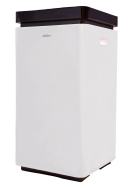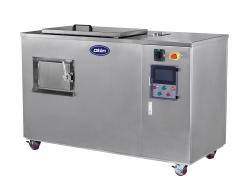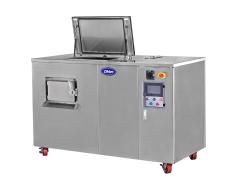Food Waste Treatment :
Composting Machine
Hong Kong presently disposes of about 3,500 tonnes of food waste to the landfills each day, of which about 2,400 tonnes were produced from the domestic households. The disposal of food waste to landfills depletes our valuable landfill space. To tackle the food waste disposal problem, the government’s strategy is to avoid and to minimize food waste generation, and to recycle the inevitable food waste to useful resources. Nicole presents composting machine to resolve the food waste problem.
System Description
The food waste decomposition system is designed for rapid composting performance. It is used for small to large scale restaurants, hotels, schools, communities, offices and cafeterias. Depending on model, it can process from 2 to 500 tons of food waste per year. The system does not require any special installation. Simply connect the machines to an electrical outlet and the system is ready to operate. The one-touch control is fully automatic, sensing composting status and providing feedback and control to the operation without pre-setting a timer.
Benefits
- As much as 90% volume reduction of food solid waste.
- Low labor cost – automated function; full operation can be accomplished by one person for any model.
- No secondary pollution or handling noise on-site.
- No wastewater.
- No landfill costs.
- Low maintenance.
Composting Machine Description
The entire machine is constructed of stainless steel. The compositing chamber has an internal means of mechanical agitation. The chamber has an oil jacket with substantial insulation and well sealed inlet and outlet doors to minimize energy consumption. The system is equipped with an odor management device to control odors associated with the composting process. The utility requirements are only (1) an electrical connection and (2) a condensate drain line (provided); there is no unpleasant odor and no waste water. The decomposing chamber is capable of producing 60-70°C during processing to insure that the end product has a mild odor and is free of harmful bacteria. The end product can be considered as a soil amendment suitable for use in landscaping.



Machine Operation
The machine composts waste using an energy-efficient and automated control process. The system employs high temperature microorganisms to decompose food waste and organic matter. This is accomplished without the need for repeated additions of microorganisms and other additives to the composting chamber. Recycling technology uses the condensate run off to control the humidity in the processing chamber during the process. The system also recycles heat energy in order to reduce overall energy consumption. The processing time will vary depending on the waste input but normal mixed food waste should take no longer than 24 hours to virtually disappear.
Turning food waste into compost in 24 hours: Your contribution to the natural life cycle.
There are numerous microorganisms in nature, including fungi and bacteria, and some of the microorganisms are capable of turning food waste into compost. Some are more efficient than others, and we use the most efficient. Using these microorganisms, GreenGood composts food waste within 24 hours.
A total solid waste solution!
Using Nicole decomposition system to deal with food waste, the resulting compost can be used as organic fertilizer for soil improvement.There are two ways this can work :
Easy Processing
Residents or community property management personnel can mix soil with compost in the ratio of 1:10 for basic soil fertilizer use. This is easy to operate for community gardens and to establish a ‘green loop’ ecosystem.
Centralized Processing
If the user or community can not use compost, our company can recover it through a simple process, and then through a granulation process (according the national standard NY525) create a commercial grade organic fertilizer. It can then be used for a variety of different purposes, such as fruit and vegetable planting, flower planting, landscaping and other uses that require specific nutrient conditions, as well as the organic fertilizer market.

